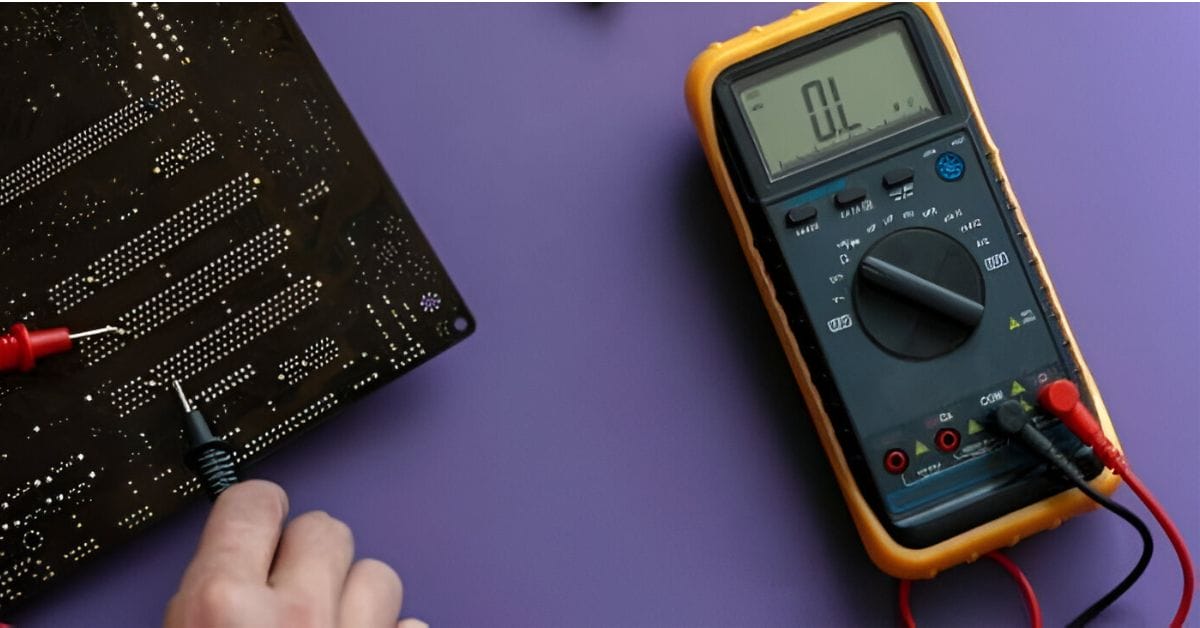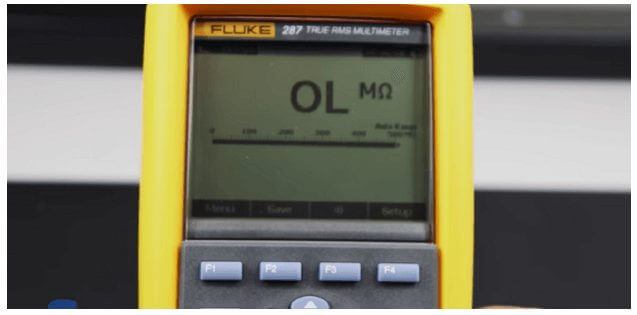What Does OL Mean on a Multimeter? (Guide)

Let’s chat about that mysterious ‘OL’ reading you’ve probably seen popping up on your multimeter. No worries, I’m here to guide you through it.
‘OL’ stands for ‘Open Loop,’ but it’s telling you one of a few things. It could mean an open loop with no complete path for the current to flow. It can also indicate insufficient continuity.
In this article, we’re diving into how to interpret the ‘OL’ (Open Loop) on your multimeter. Plus, I’ll share some common slip-ups to avoid. Let’s get to it!
OL Reading on a Multimeter

‘OL’ stands for ‘Open Loop.’ Think of it as trying to converse through a phone that’s not connected. It means there’s no feedback loop in whatever you’re measuring. This little acronym can pop up in a bunch of different scenarios.
When You’re Testing Continuity
Imagine you’re testing a wire to see if electricity can travel through it smoothly. If your multimeter shows ‘OL,’ there’s no path for the current to travel from one probe to another. I’ve had this happen when I was checking old wires in my garage – they were as good as broken!
Testing Voltage
Now, let’s say you’re measuring voltage. If you see ‘OL’ on your multimeter, it’s saying the voltage is too high or out of range.
Don’t worry. Your multimeter’s fine – it’s just asking you to adjust your settings. I learned this the hard way when working on a vintage amplifier and almost thought I had fried my equipment!
Testing Resistance
When you’re measuring resistance and ‘OL’ shows up, it’s a sign there’s no continuity. It’s like infinite resistance – an uncrossable gap in your circuit.
Testing Current Flow
Is it measuring current, especially in high-current circuits like a car engine, and getting an ‘OL’? That’s your multimeter’s way of waving a white flag, saying it’s too much to handle. I’ve seen this a couple of times while working on car engines. It’s a hint to step back and reassess.
When you see ‘OL’ during any electrical test, it tells you something’s up. It could be a break in continuity or just an overload situation. ‘OL’ is not a reason to panic – it’s just a reason to pause and figure out your next move.
Decoding Multimeter Readings: Comparing ‘OL’ with ‘0’ and Specific Voltage Readings
Let’s compare ‘OL’ with other common multimeter readings to get a full picture. Think of your multimeter as a storyteller; each reading tells a different tale.

‘OL,’ as we know, is an ‘Open Loop,’ indicating a break in continuity or an overload. Now, contrast that with a ‘0’ reading.
Zero is there’s complete continuity, no resistance. I’ve seen this when checking a perfectly good wire – the current flows through without a hitch.
Then, there are specific voltage readings. Let’s say your multimeter shows 5 volts. That’s like getting precise directions – it tells you exactly how much electrical pressure is there.
Understanding these differences is key. While ‘OL’ raises a red flag, ‘0’ or exact voltages give you the necessary green light or specific info. It’s all about interpreting the story your multimeter tells you.
Common Multimeter Missteps: Navigating the ‘OL’ Reading Like a Pro

Let’s break down some common mistakes to avoid.
Misinterpreting OL as a Device Malfunction
One of the first blunders I’ve seen (and, okay, I’ll admit, made myself once upon a time) is thinking ‘OL’ means your multimeter has gone kaput.
‘OL’ generally stands for ‘Open Loop,’ not ‘Oh Lord, the multimeter’s broken!’. It’s trying to tell you that it can’t make a reading, often because what you’re testing has too high resistance or no continuity.
Overlooking the Simple Stuff
Sometimes, the simplest answer is right, but we overlook it. I remember this time I was helping a buddy with his car, and we kept getting an ‘OL’ reading.
We were scratching our heads for hours. We were not probing the connectors properly – talk about a facepalm moment! Always ensure your test probes are securely connected, and the component or circuit you’re testing is properly set up for your measurement.
Not Switching Settings
Another common mix-up? Not using the right setting on your multimeter. These gadgets are like Swiss Army knives – versatile but only effective if you use them right.
I’ve seen folks trying to measure the resistance on a voltage setting and then wondering why the multimeter reads ‘OL.’ Double-check you’re on the right setting for what you’re trying to measure.
Ignoring the Possibility of a Blown Fuse
Here’s a kicker – sometimes the ‘OL’ reading might be due to a blown fuse in your multimeter.
Before testing, give your multimeter a once-over to ensure all is well under the hood. Replacing a blown fuse is often all it takes to get back on track.
Forgetting About Range Limits
Remember, every multimeter has its limits. If you’re trying to measure something beyond its range, ‘OL’ will be your multimeter’s way of waving a white flag. Adjust the range or get a multimeter that can handle higher values.
So there you have a few common pitfalls to avoid when you’re out there, multimeter in hand, ready to conquer the world of electronics.
Frequently Asked Questions
- How Do I Reset My Multimeter After an ‘OL’ Reading?
- After getting an ‘OL’ reading, you can reset your multimeter by turning it off and on again or switching to a different measurement mode. It’s like giving your tool a quick reboot.
- What Precautions Should I Take When an ‘OL’ Reading Occurs?
- Ensure the device under test is powered off, and double-check your multimeter’s range and settings. Ensuring safety first is crucial, especially when ‘OL’ indicates a potential overload.
- Can Weather or Temperature Affect ‘OL’ Readings?
- Extreme temperatures can affect electronic devices, including multimeters. Using the multimeter within its specified operating temperature range is best to avoid false readings.
- Is ‘OL’ Reading Common in Old or Damaged Multimeters?
- Older or damaged multimeters might show ‘OL’ more frequently, especially if they have worn-out components or calibration issues.
- How Can I Test My Multimeter’s Accuracy After an ‘OL’ Reading?
- To test its accuracy, use your multimeter to measure a known voltage or resistance, like a battery or a resistor, and compare it with the expected value.
References
Organizations:
- Fluke Corporation. https://www.fluke.com/
Books:
- Multimeters 101: Basic Operation, Care and Maintenance, and Advanced Troubleshooting for the Skilled Trades” by B. Phifer. https://ecampusontario.pressbooks.pub/multimeters101/
Website Resources:
- Multimeter101.com. https://multimeter101.com/
Video References:
GalcoTV
BTCInstrumentation
